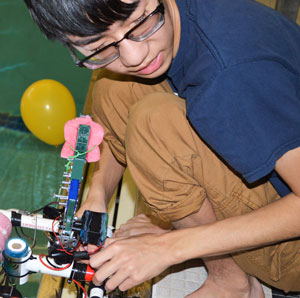As Northern High junior Cade Zimdar moved a joystick to control a robotic vehicle moving along the floor of the swimming pool at the Forest Hills Community Aquatic Center, classmate Hanna Peterson watched its progress with her face in the water.
On deck, Central High junior Selina Franovic sat in bare feet, clipping and reconfiguring wires inside a switch box that would propel her team’s vehicle in the depths.
“It’s really fun,” Selina said. “It’s almost like I’m doing crafts.”

The past couple weeks, more than 50 of Elbert Yeh’s AP Physics 1, STEM Academy and STEM AP Physics 1 students have been visiting the aquatic center, testing underwater remote-operated vehicles (UROV) they have built and programmed.
The UROV is a yearlong project that includes entry in the Innovative Underwater Vehicle Design competition on Saturday at Roseville High School near Detroit.
Yeh’s students, juniors and seniors from Northern and Central high schools, were to compete today in a handful of challenges that include a traffic jam, an underwater expressway, an underwater surveying task and an underwater drag race.
UROVs also are evaluated at the competition based on design innovation, engineering and craftsmanship, performance, ambassadorship, presentation, enthusiasm and use of social media.
Selina signed up for Northern’s STEM class not because she is particularly mechanically inclined, but because “it just seemed like the next challenge,” she said. “I didn’t really know how to do any of this before.”
Now, she said, she can see herself working in a STEM-related field such as engineering.
“I’m definitely glad I’m learning it. It’s cool to know I can make things instead of just use things.”

A Favorite Aspect: When They Break
The competition is hosted by education think tank Square One Education Network. Forest Hills is the sole Kent ISD member participating in this year’s competition, which is open to teachers who have taken Square One’s training in classroom UROVs.
Kenowa Hills has participated in ground-based challenges in the past, and will do so again in Ann Arbor on May 19.
This is the fourth year FHN has been building UROVs, but the first time the district has taken part in the competition. Twenty-nine teams of third- through 12th-graders from across the state will take part.
Yeh attended a workshop about five years ago that was aimed at giving teachers an immersive experience in designing, building and operating a UROV. The hope was they would take that back to the classroom to boost student engagement in STEM fields.
While driving home from the workshop, Yeh recalled, “I realized that I could reorganize my physics instruction and incorporate the UROV as a yearlong project that would parallel the physics content to allow students to directly apply their learning to an actual device of their own construction.

“On top of that, I had a ton of fun building my UROV, and I knew that my students would get a kick out of building one too.”
One of Yeh’s favorite aspects of the project: when it breaks, students must really problem-solve.
“I need to resist jumping in and helping them at those moments,” he said. “It’s fun to see them apply their knowledge of physics content to troubleshoot electrical and mechanical problems, even though they are frustrated that I won’t simple give them a solution.”
CONNECT
STEM on steroids: students design electronic vehicles
See how it’s done: Square One Network 2014 competition video












